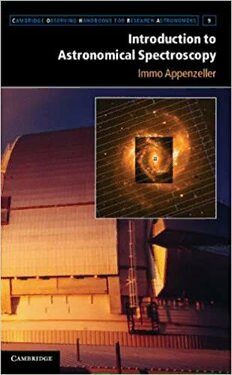Table Of ContentIntroductiontoAstronomicalSpectroscopy
SpectroscopyistheprincipaltoolusedinastronomytoinvestigatetheUniversebeyond
Earth’satmosphere.Throughtheanalysisofelectromagneticradiation,spectrographs
enable observers to assess the chemical composition, kinematics, and local physical
properties of distant stars, nebulae, and galaxies. Thoroughly illustrated and clearly
written, this handbook offers a practical and comprehensive guide to the different
spectroscopic methods used in all branches of astronomy, at all wavelengths from
radiotogamma-ray,andfromgroundandspace-borneinstruments.Afterahistorical
overviewofthefield,thecentralchaptersnavigatethevarioustypesofhardwareused
in spectroscopy. In-depth descriptions of modern techniques and their benefits and
drawbacks help you choose the most promising observation strategy. The handbook
finishesbyassessingnewtechnologiesandfutureprospectsfordeep-skyobservation.
Thistextisanidealreferencefortoday’sgraduatestudentsandactiveresearchers,as
wellasthosedesigningoroperatingspectroscopicinstruments.
immo appenzeller is Emeritus Professor of Astronomy at the University of
Heidelberg,Germany,andDirectoroftheHeidelbergStateObservatory.
Downloaded from https://www.cambridge.org/core. Nottingham Trent University, on 22 Aug 2019 at 20:52:16, subject to the Cambridge Core
terms of use, available at https://www.cambridge.org/core/terms. https://doi.org/10.1017/CBO9781139059503
Downloaded from https://www.cambridge.org/core. Nottingham Trent University, on 22 Aug 2019 at 20:52:16, subject to the Cambridge Core
terms of use, available at https://www.cambridge.org/core/terms. https://doi.org/10.1017/CBO9781139059503
CambridgeObservingHandbooksforResearchAstronomy
Today’sprofessionalastronomersmustbeabletoadapttousetelescopesand
interpretdataatallwavelengths.Thisseriesisdesignedtoprovidethemwith
acollectionofconcise,self-containedhandbooks,whichcoversthebasicprin-
ciplespeculiartoobservinginaparticularspectraregion,ortousingaspecial
techniqueortypeofinstrument.Thebookscanbeusedasanintroductionto
thesubjectandasahandyreferenceforuseatthetelescopeorintheoffice.
Serieseditors
Professor Richard Ellis, Department of Astronomy, California Institute of
Technology
ProfessorSteveKahn,DepartmentofPhysics,StanfordUniversity
ProfessorGeorgeRieke,StewardObservatory,UniversityofArizona,Tuscon
Dr Peter B. Stetson, Herzberg Institute of Astrophysics, Dominion Astro-
physicalObservatory,Victoria,BritishColumbia
Bookscurrentlyavailableinthisseries:
1. HandbookofInfraredAstronomy
I.S.Glass
4. HandbookofPulsarAstronomy
D.R.LorimerandM.Kramer
5. HandbookofCCDAstronomy,SecondEdition
SteveB.Howell
6. IntroductiontoAstronomicalPhotometry,SecondEdition
EdwinBuddingandOsmanDemircan
7. HandbookofX-rayAstronomy
EditedbyKeithArnaud,RandallSmith,andAnetaSiemiginowska
8. PracticalStatisticsforAstronomers,SecondEdition
J.V.WallandC.R.Jenkins
9. IntroductiontoAstronomicalSpectroscopy
ImmoAppenzeller
Downloaded from https://www.cambridge.org/core. Nottingham Trent University, on 22 Aug 2019 at 20:52:16, subject to the Cambridge Core
terms of use, available at https://www.cambridge.org/core/terms. https://doi.org/10.1017/CBO9781139059503
Downloaded from https://www.cambridge.org/core. Nottingham Trent University, on 22 Aug 2019 at 20:52:16, subject to the Cambridge Core
terms of use, available at https://www.cambridge.org/core/terms. https://doi.org/10.1017/CBO9781139059503
Introduction to Astronomical
Spectroscopy
IMMO APPENZELLER
CenterforAstronomy
UniversityofHeidelberg
Downloaded from https://www.cambridge.org/core. Nottingham Trent University, on 22 Aug 2019 at 20:52:16, subject to the Cambridge Core
terms of use, available at https://www.cambridge.org/core/terms. https://doi.org/10.1017/CBO9781139059503
cambridgeuniversitypress
Cambridge,NewYork,Melbourne,Madrid,CapeTown,
Singapore,Sa˜oPaulo,Delhi,MexicoCity
CambridgeUniversityPress
32AvenueoftheAmericas,NewYork,NY10013-2473,USA
www.cambridge.org
Informationonthistitle:www.cambridge.org/9781107601796
©ImmoAppenzeller2013
Thispublicationisincopyright.Subjecttostatutoryexception
andtotheprovisionsofrelevantcollectivelicensingagreements,
noreproductionofanypartmaytakeplacewithoutthewritten
permissionofCambridgeUniversityPress.
Firstpublished2013
PrintedintheUnitedStatesofAmerica
AcatalogrecordforthispublicationisavailablefromtheBritishLibrary.
LibraryofCongressCataloginginPublicationdata
Appenzeller,I.(Immo),1940–
Introductiontoastronomicalspectroscopy/ImmoAppenzeller.
pages cm.–(Cambridgeobservinghandbooksforresearchastronomers;9)
Includesbibliographicalreferencesandindex.
ISBN978-1-107-01579-1(hardback)–ISBN978-1-107-60179-6(paperback)
1.Astronomicalspectroscopy. I.Title.
QB465.A67 2013
522(cid:2).67–dc23 2012019846
ISBN978-1-107-01579-1Hardback
ISBN978-1-107-60179-6Paperback
CambridgeUniversityPresshasnoresponsibilityforthepersistenceoraccuracyofURLs
forexternalorthird-partyInternetWebsitesreferredtointhispublicationanddoesnot
guaranteethatanycontentonsuchWebsitesis,orwillremain,accurateorappropriate.
Downloaded from https://www.cambridge.org/core. Nottingham Trent University, on 22 Aug 2019 at 20:52:16, subject to the Cambridge Core
terms of use, available at https://www.cambridge.org/core/terms. https://doi.org/10.1017/CBO9781139059503
Contents
Preface pagexi
1 HistoricalRemarks 1
1.1 EarlyPioneers 1
1.2 ThePhotographicEra 6
1.3 TheImpactofLinearDetectors 10
1.4 ExtendingtheWavelengthRange 19
2 SpectroscopyinPresent-DayAstronomy 26
2.1 SpectralClassification 26
2.2 RadialVelocities 30
2.3 GravitationalandCosmologicalRedshifts 32
2.4 AstrophysicalApplications 35
2.5 MagneticFields 43
2.6 TheImportanceofSpectralResolution 46
3 BasicPhysicsofSpectralMeasurements 50
3.1 ElectromagneticRadiation 50
3.2 MeasuringFrequencies 54
3.3 MeasuringWavelengths 55
3.4 AccuracyLimits 76
4 Optical-RangeGratingandPrismSpectrometers 81
4.1 CommerciallyAvailableSpectrometers 81
4.2 BasicComponentsofAstronomicalSpectrometers 82
4.3 SlitlessSpectroscopy 85
4.4 Single-ObjectSlitSpectrometers 87
4.5 Fiber-CoupledInstruments 107
vii
Downloaded from https://www.cambridge.org/core. Nottingham Trent University, on 22 Aug 2019 at 20:53:11, subject to the Cambridge Core
terms of use, available at https://www.cambridge.org/core/terms. https://doi.org/10.1017/CBO9781139059503
viii Contents
4.6 MultiobjectSpectrometers 110
4.7 IntegralFieldSpectroscopy 115
4.8 ColdIRSpectrometers 119
5 OtherTechniquesfortheOpticalSpectralRange 127
5.1 Fabry-PerotTechniques 127
5.2 FourierTransformSpectrometers 134
5.3 DirectDetectionofVisualPhotonEnergies 138
6 PreparingandReducingOpticalObservations 145
6.1 PlanningandPreparingObservingRuns 145
6.2 TheExecutionPhase 154
6.3 CalibrationProcedures 156
6.4 ReductionofRawSpectra 159
6.5 ArchivingSpectralData 176
7 UV,X-Ray,andGammaSpectroscopy 179
7.1 UVandX-RayOptics 180
7.2 UVSpectrometers 187
7.3 Photon-EnergySensitiveX-RayDetectors 189
7.4 X-RayGratingSpectrometers 191
7.5 GammaSpectroscopy 194
8 SpectroscopyatRadioWavelengths 200
8.1 DetectionofRadioWavesfromSpace 201
8.2 FilterBanks 203
8.3 FastFourier-TransformSpectrometers 204
8.4 AutocorrelationTechniques 206
8.5 Cross-CorrelationSpectroscopywithArrays 209
8.6 Acousto-OpticalInstruments 210
8.7 Chirp-TransformSpectrometers 212
9 SpecialTechniquesoftheFIRand
SubmillimeterRange 214
9.1 SpectroscopywithBolometers 215
9.2 HeterodyneSpectroscopyatFIRandSubmillimeter
Wavelengths 221
10 NewDevelopmentsandFutureProspects 224
10.1 ScientificDrivers 224
10.2 NewFacilities 225
Downloaded from https://www.cambridge.org/core. Nottingham Trent University, on 22 Aug 2019 at 20:53:11, subject to the Cambridge Core
terms of use, available at https://www.cambridge.org/core/terms. https://doi.org/10.1017/CBO9781139059503
Contents ix
10.3 NewTechnologies 231
10.4 OrganizationalChallenges 236
Appendix:ListofAcronyms 239
References 245
Index 251
Downloaded from https://www.cambridge.org/core. Nottingham Trent University, on 22 Aug 2019 at 20:53:11, subject to the Cambridge Core
terms of use, available at https://www.cambridge.org/core/terms. https://doi.org/10.1017/CBO9781139059503

